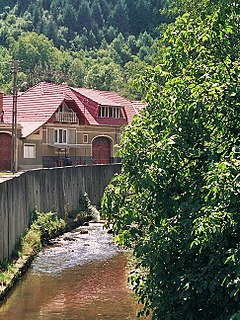
Ilfov is the county that surrounds Bucharest, the capital of Romania. It used to be largely rural, but, after the fall of communism, many of the county's villages and communes developed into high-income commuter towns, which act like suburbs or satellites of Bucharest. The gentrification of the county is continuing, with many towns in Ilfov, such as Otopeni, having some of the highest GDP per capita levels in the country.

The Bistrița is a river in the Romanian regions of Maramureș, Bukovina and Moldavia. It is a right tributary of the river Siret. Near Bacău it flows into the Siret. Its source is in the Rodna Mountains, at the foot of the Gârgalău peak. It flows through the counties Bistrița-Năsăud, Suceava, Neamț and Bacău. The towns Vatra Dornei, Bicaz, Piatra Neamț, Roznov, Buhuși and Bacău lie along the Bistrița. The Bistrița is 283 km long, and its basin area is 7039 km².

The Olt is a river in Romania. It is 615 km (382 mi) long, and its basin area is 24,050 km2 (9,290 sq mi). It is the longest river flowing exclusively through Romania. Its source is in the Hășmaș Mountains of the eastern Carpathian Mountains, near Bălan, rising close to the headwaters of the Mureș River. It flows through the Romanian counties Harghita, Covasna, Brașov, Sibiu, Vâlcea and Olt. The river was known as Alutus or Aluta in Roman antiquity. Olt County and the historical province of Oltenia are named after the river.

The Argeș is a river in Southern Romania. It is 350 km (220 mi) long, and its basin area is 12,550 km2 (4,850 sq mi). Its source is in the Făgăraș Mountains, in the Southern Carpathians and it flows into the Danube at Oltenița.

The Prahova River is a river of Southern Romania, which rises from the Bucegi Mountains, in the Southern Carpathians. It flows into the Ialomița near Adâncata. The upper reach of the river, upstream of the junction with the Azuga River is sometimes called the Prahovița River.

The Arieș is a left tributary of the river Mureș in Transylvania, Romania. It discharges into the Mureș in Gura Arieșului, 11 km southwest of Luduș. Its total length is 166 km (103 mi), and its drainage basin area is 3,005 km2 (1,160 sq mi).

King Michael I Park, formerly Herăstrău Park, is a large park on the northern side of Bucharest, Romania, around Lake Herăstrău, one of the lakes formed by the Colentina River.

The Buzău is a river in eastern Romania, tributary of the river Siret. Its total length is 302 km, and its drainage basin area is 5,264 km2. Its source is in the south-eastern Carpathian Mountains, east of Brașov. The Buzău flows through the Romanian counties Brașov, Covasna, Buzău and Brăila. It flows into the Siret close to its confluence with the Danube, west of Galați.

Cibin is a river in central Romania, in the south part of Transylvania. Its source is in the Cindrel Mountains of the Southern Carpathian Mountains. The river is formed at the confluence of two headwaters: Râul Mare and Râul Mic. The river flows entirely in Sibiu County. The source is close to the highest peak in the Cibin Mountains.

Râul Doamnei is a left tributary of the river Argeș in Romania. It discharges into the Argeș just north of Pitești. It is formed at the confluence of headwaters Valea Rea and Zârna River. It is 98 kilometers in length and frequently dries up in summer, owing to the works upstream that have redirected part of its water supply toward a reservoir serving the hydroelectric plant on the Argeș.
Calea Victoriei is a major avenue in central Bucharest. It leads from Splaiul Independenței to the north and then northwest up to Piața Victoriei, where Șoseaua Kiseleff continues north.

The Lotru is a right tributary of the Olt River in Romania. Its source is in the Parâng Mountains. It flows into the Olt near the town Brezoi. It passes through the communes Voineasa, Malaia, and Brezoi.

The Latorița is a right tributary of the river Lotru in Romania. It discharges into the Lotru near Valea Măceșului.

The Gilort is a river in southern Romania, a left tributary of the river Jiu. The Gilort flows through the villages and towns Novaci, Bălcești, Bengești, Târgu Cărbunești, Jupânești, Turburea and Capu Dealului.

The Lăpuș River is a right tributary of the river Someș in Romania. It is formed at the confluence of the headwaters Izvorul Alb and Izvorul Negru. It discharges into the Someș in Bușag, west of Baia Mare. It flows through the communes Băiuț, Lăpuș, Târgu Lăpuș, Vima Mică, Șomcuta Mare, Remetea Chioarului, Coaș, Săcălășeni, Groși, Coltău, Recea and Tăuții-Măgherăuș.
The Suciu River is a left tributary of the river Lăpuș in Maramureș County, Romania. It discharges into the Lăpuș near Copalnic-Mănăștur. The upper reach is sometimes referred to as Groși River or Minghet River or Jijia River.
The Șușița River is a right tributary of the river Siret in Romania. It discharges into the Siret in Doaga. It flows through the following towns and villages, from source to mouth: Rucăreni, Dragosloveni, Rotileștii Mari, Câmpuri, Gogoiu, Răcoasa, Varnița, Repedea, Panciu, Satu Nou, Tișița and Doaga.

The Orăștie River is a left tributary of the river Mureș in Romania. It discharges into the Mureș near the town Orăștie.
As a result of snowmelt, Bucharest, the capital of Romania, was hit by the worst flooding in its history. Although the death toll is unknown, documents attest a large number of dead and displaced people. At people's pressure, Prince Alexandru Ioan Cuza started a project of sewering the Dâmbovița River, which concretized only in 1880, after the plans of engineer Grigore Cerkez. Modern facilities were built to supply water to the city and 12 bridges.

![]()































